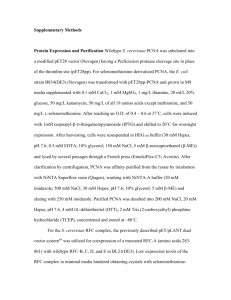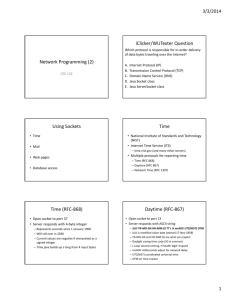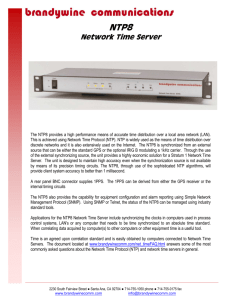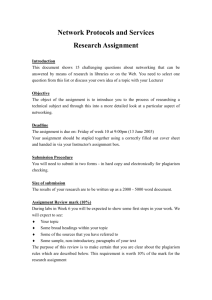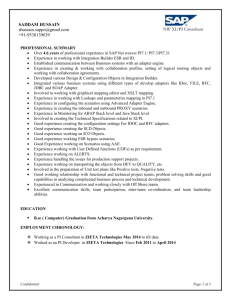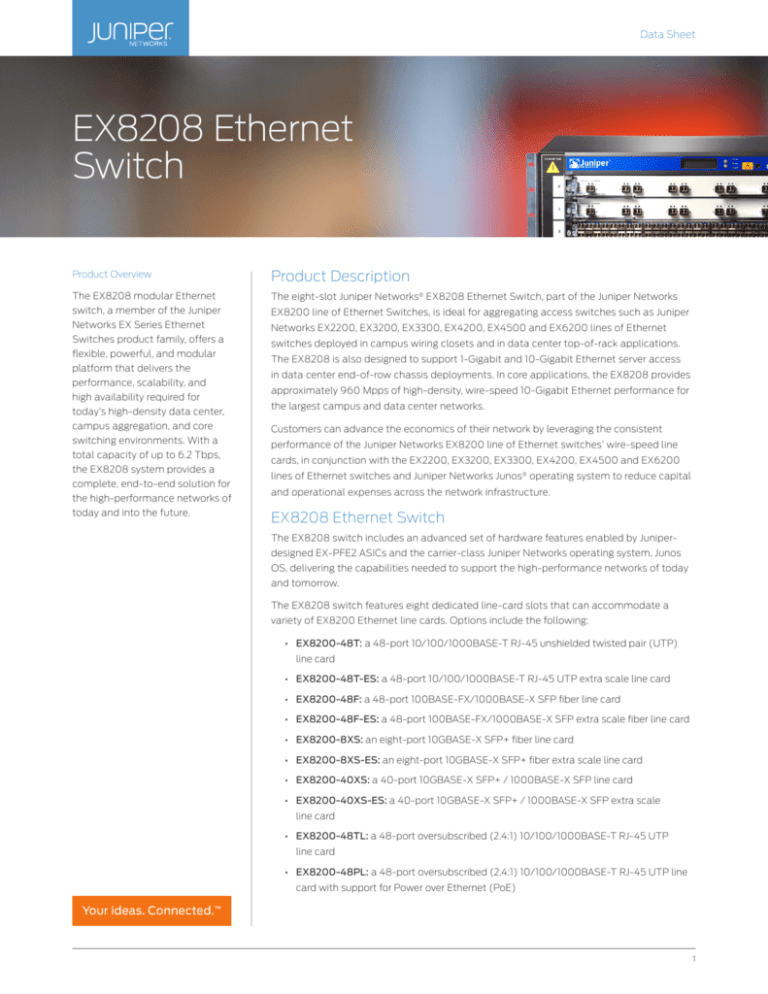
Data Sheet
EX8208 Ethernet
Switch
Product Overview
Product Description
The EX8208 modular Ethernet
The eight-slot Juniper Networks® EX8208 Ethernet Switch, part of the Juniper Networks
switch, a member of the Juniper
EX8200 line of Ethernet Switches, is ideal for aggregating access switches such as Juniper
Networks EX Series Ethernet
Networks EX2200, EX3200, EX3300, EX4200, EX4500 and EX6200 lines of Ethernet
Switches product family, offers a
switches deployed in campus wiring closets and in data center top-of-rack applications.
flexible, powerful, and modular
platform that delivers the
performance, scalability, and
high availability required for
today’s high-density data center,
The EX8208 is also designed to support 1-Gigabit and 10-Gigabit Ethernet server access
in data center end-of-row chassis deployments. In core applications, the EX8208 provides
approximately 960 Mpps of high-density, wire-speed 10-Gigabit Ethernet performance for
the largest campus and data center networks.
campus aggregation, and core
Customers can advance the economics of their network by leveraging the consistent
switching environments. With a
performance of the Juniper Networks EX8200 line of Ethernet switches’ wire-speed line
total capacity of up to 6.2 Tbps,
the EX8208 system provides a
complete, end-to-end solution for
the high-performance networks of
today and into the future.
cards, in conjunction with the EX2200, EX3200, EX3300, EX4200, EX4500 and EX6200
lines of Ethernet switches and Juniper Networks Junos® operating system to reduce capital
and operational expenses across the network infrastructure.
EX8208 Ethernet Switch
The EX8208 switch includes an advanced set of hardware features enabled by Juniperdesigned EX-PFE2 ASICs and the carrier-class Juniper Networks operating system, Junos
OS, delivering the capabilities needed to support the high-performance networks of today
and tomorrow.
The EX8208 switch features eight dedicated line-card slots that can accommodate a
variety of EX8200 Ethernet line cards. Options include the following:
• EX8200-48T: a 48-port 10/100/1000BASE-T RJ-45 unshielded twisted pair (UTP)
line card
• EX8200-48T-ES: a 48-port 10/100/1000BASE-T RJ-45 UTP extra scale line card
• EX8200-48F: a 48-port 100BASE-FX/1000BASE-X SFP fiber line card
• EX8200-48F-ES: a 48-port 100BASE-FX/1000BASE-X SFP extra scale fiber line card
• EX8200-8XS: an eight-port 10GBASE-X SFP+ fiber line card
• EX8200-8XS-ES: an eight-port 10GBASE-X SFP+ fiber extra scale line card
• EX8200-40XS: a 40-port 10GBASE-X SFP+ / 1000BASE-X SFP line card
• EX8200-40XS-ES: a 40-port 10GBASE-X SFP+ / 1000BASE-X SFP extra scale
line card
• EX8200-48TL: a 48-port oversubscribed (2.4:1) 10/100/1000BASE-T RJ-45 UTP
line card
• EX8200-48PL: a 48-port oversubscribed (2.4:1) 10/100/1000BASE-T RJ-45 UTP line
card with support for Power over Ethernet (PoE)
Your ideas. Connected.™
1
EX8208 Ethernet Switch
• EX8200-2XS-40T: a combination line card with 40
oversubscribed (2.5:1) 10/100/1000BASE-T RJ-45 UTP ports,
four line-rate 100/1000BASE-SX SFP ports and two line-rate
10GbE SFP+ ports
Data Sheet
Table 1: EX8208 Features at a Glance
Features
Description
Chassis
•
•
•
•
Power
• Energy efficiency: Up to 195,000 packets per
second per watt
• 6 load-sharing power supplies
• 10,000 W maximum power capacity
• 220 V AC, 110 V AC and -48 V DC options for N+1
or N+N redundancy
Cooling
• Redundant variable-speed fans and controllers
• Side-to-side airflow
Fabric
• 320 Gbps (full duplex) per slot fabric capacity
• 2+1 redundancy with dual SREs and SF card
• Full line-rate forwarding with two fabrics in
system
Routing engine
•
•
•
•
Operating
system
• Junos OS
High
availability
Hardware designed for continuous operation:
• Secure, modular architecture isolates faults
• Separate control and forwarding planes enhance
scalability and resiliency
• Transparent failover and network recovery
• Graceful Route Engine Switchover (GRES)
• Nonstop Routing (NSR)
• Nonstop Bridging (NSB)
• Non-Stop Software Upgrade (NSSU)
Layer 2
features
•
•
•
•
•
• EX8200-2XS-40P: a combination line card with 40
oversubscribed (2.5:1) 10/100/1000BASE-T RJ-45 UTP PoE+
ports, four line-rate 100/1000BASE-SX SFP ports and two
line-rate 10GbE SFP+ ports
Fully configured, a single EX8208 chassis can support up to
384 Gigabit Ethernet or 64 10-Gigabit Ethernet ports at wire
speed, or 320 10-Gigabit Ethernet ports in shared bandwidth
applications, delivering one of the industry’s highest 10-Gigabit
Ethernet port densities.
At 14 rack-units (RUs) high, three EX8208 Ethernet Switches
can fit in a standard 42 RU rack, enabling up to 1,152 Gigabit
Ethernet or 960 10-Gigabit Ethernet ports in a single rack.
At just 21 inches deep, the EX8208 is sufficiently compact
to fit into typical wiring closets, making it ideal for campus
deployments where space is at a premium.
The EX8208 features a switch fabric that is capable of delivering
320 Gbps (full duplex) per slot, enabling scalable wire-rate
performance on all ports for any packet size. The passive backplane
design supports a future capacity of up to 6.2 Tbps, providing a
built-in migration path to next-generation deployments.
The base-configuration EX8208 Ethernet Switch includes a
side-mounted hot-swappable fan tray with variable-speed fans,
one Switch Fabric and Routing Engine (SRE) module, and one
dedicated Switch Fabric module. Base EX8208 switches also
ship with either two 2000 watt or two 3000 watt power supplies,
although six power supply bays allow users to provision the
chassis to provide the power and redundancy required for any
•
•
Layer 3
features
•
•
•
•
•
•
•
•
•
•
Static routing
RIP v1/v2
OSPF v1/v2
Filter-based forwarding
Virtual Router Redundancy Protocol (VRRP)
BGP (Advanced Feature license)
IS-IS (Advanced Feature license)
IPv6 (Advanced Feature license)
Bidirectional Forwarding Detection (BFD)
Virtual routers
Hardware
tunneling
• GRE tunnels*
• M
PLS capabilities (Advanced feature license)
Multicast
• Internet Group Management Protocol (IGMP)
v1/v2/v3
• IGMP snooping v1/v2/v3
• Protocol Independent Multicast PIM-SM, PIMSSM, PIM-DM, MSDP
SRE module for hot-standby resiliency while AC or DC power
options provide complete redundancy, reliability, and availability.
•
•
•
All components are accessible from the front, simplifying repairs
and upgrades.
A front-panel chassis-level LCD panel displays Routing Engine
status as well as chassis component alarm information for
operations. The LCD also provides a flexible, user-friendly
1+1 redundancy
Master and backup SREs
2 gigabytes DRAM; 2 gigabytes Flash memory
Console + auxiliary serial and Ethernet
management ports
• USB storage interface
Jumbo frames (9216 Bytes)
4,096 VLANs
VLAN Registration Protocol (GVRP)
Private VLAN (PVLAN)
802.3ad – Link Aggregation Control Protocol
(LACP)
802.1D – Spanning Tree Protocol (STP)
802.1w – Rapid Spanning Tree Protocol (RSTP)
802.1s – Multiple Instance Spanning Tree
Protocol (MSTP)
VLAN Spanning Tree Protocol (VSTP)
Redundant Trunk Group (RTG)
application. Redundant EX8208 configurations include a second
rapid problem identification and resolution to simplify overall
14 RU; 21 in (53 cm) deep; 17.25 in (43.8 cm) wide
8 dedicated I/O slots
6.2 Tbps backplane capacity
Dedicated data, control, and management
planes
• LCD panel for system monitoring
interface for performing device initialization and configuration
rollbacks, reporting system status and alarm notification, or
restoring the switch to its default settings.
* Roadmap
2
EX8208 Ethernet Switch
Data Sheet
MX Series
EX8200
Virual Chassis
SRX5800
STP
EX8200
Virual Chassis
Servers
EX4200
EX4500
Servers
NAS
Figure 1: EX8208 Ethernet switches with Virtual Chassis technology offer a high-density, scalable solution for aggregating
10-Gigabit Ethernet uplinks from access-layer devices in the data center.
Features
Description
Firewall filters
• Ingress and egress L2-L4 access control lists
(ACLs):
- Port ACLs
- VLAN ACLs
- Router ACLs
• Control plane denial of service (DoS) protection
Quality of
service (QoS)
Management
• 2,000 policers per chassis
• 8 egress queues per port
• Weighted Random Early Drop (WRED)
scheduling
• Shaped Deficit Weighted Round Robin (SDWRR)
queuing
• Strict priority queuing
• Multi-field classification (L2 – L4) for scheduling
and rewrite
• Junos OS command-line interface (CLI)
• Junos XML management protocol
• Embedded Web-based management – Junos
Web
• Network and Security Manager (NSM) support
• LCD panel
• SNMP v1/v2/v3
• RADIUS
• TACACS+
• Extensive MIB support
• Local and remote analyzer (mirroring)
• Link Layer Discovery Protocol (LLDP)
• Advanced Insight Solutions (AIS)
Deployment Scenarios
The EX8208 switch is optimized for both data center and
campus aggregation and core deployments.
In the data center, the EX8208 switch delivers a highperformance, high-density platform that reduces cost and
complexity while improving overall scalability and providing
carrier-class reliability. Populated with eight-port EX8200-8XS
10-Gigabit Ethernet line cards, the EX8208 can accommodate
large numbers of high-speed, line-rate uplinks at any packet size
from access layer devices such as EX4200 switches deployed
in Virtual Chassis top-of-rack configurations, offering a scalable
solution for supporting more servers with fewer switches. Using
the 40-port EX8200-40XS 10-Gigabit Ethernet line card, the
EX8208 can support a similar number of servers using traditional
standalone top-of-rack or blade-server switches.
3
EX8208 Ethernet Switch
Data Sheet
Building A
Building A
Floor n
Floor n
Floor 3
Floor 3
Access
Floor 2
Floor 2
Floor 1
Floor 1
Four Member EX8200
Virtual Chassis at the Core
Figure 2: A campus aggregation/core environment can be managed as a single device with an EX8208 Virtual Chassis configuration.
With its high Gigabit Ethernet and 10-Gigabit Ethernet port
member switches can be separated by distances of up to 40 km
densities, the EX8208 can also serve as an end-of-row server
(up to 70 km using ZR optics*). In a CWDM/DWDM network, the
access switch. High-density Gigabit Ethernet and 10-Gigabit
distance between member chassis can be extended beyond 70
Ethernet ports on the EX8208 enable the consolidation
km. If the EX8200 Virtual Chassis switch members are located in
of aggregation and core layers, simplifying the data center
the same or adjacent racks, low cost direct attach cables (DACs)
architecture while reducing power, space, and cooling
can be used as the interconnect mechanism.
requirements, and lowering total cost of ownership (TCO).
Since the network fabric created by an EX8200 Virtual Chassis
The EX8208 switch has a similar impact on campus aggregation
configuration prevents loops, it eliminates the need for protocols
and core environments, where high port densities and carrier-
such as Spanning Tree. The fabric also simplifies the network
class performance enable the switch to support more users with
by eliminating the need for Virtual Router Redundancy Protocol
less equipment than traditional solutions. For example, EX4200
(VRRP), increasing the scalability of the network design. In
switches deployed in Virtual Chassis configurations provide
addition, since the Virtual Chassis Control Protocol (VCCP)
network access for every floor or building throughout a campus
used to form the EX8200 Virtual Chassis configuration does not
with 10-Gigabit Ethernet uplinks; the high-density EX8208 can
affect the function of the control plane, Junos OS control plane
aggregate Virtual Chassis uplinks within a single platform to
protocols such as 802.3ad, OSPF, Internet Group Management
provide high-performance, line-rate connectivity to core switches
Protocol (IGMP), Physical Interface Module (PIM), BGP and
or WAN edge routers.
others running on an EX8200 Virtual Chassis system behave in
Virtual Chassis Technology
The EX8208 supports Juniper Networks’ unique Virtual Chassis
technology, which enables up to four interconnected EX8200
chassis—any combination of EX8208s or EX8216s—to operate
as a single, logical device with a single IP address. Deployed as a
collapsed aggregation or core layer solution, an EX8200 Virtual
Chassis configuration creates a network fabric for interconnecting
access switches, routers, and service-layer devices such as firewalls
and load balancers using standards-based Ethernet LAGs.
In a Virtual Chassis configuration, EX8200 switches can be
interconnected using either single line-rate 10GbE links or a LAG
with up to 12 10GbE line-rate links. Since the Virtual Chassis intra-
exactly the same way as when running on a standalone chassis.
EX8200 Virtual Chassis configurations are highly resilient, with no
single point of failure, ensuring that no single element—whether a
chassis, a line card, a Routing Engine, or an interconnection—can
render the entire fabric inoperable following a failure. Virtual
Chassis technology also makes server virtualization at scale
feasible by providing simple L2 connectivity over a very large pool
of compute resources located anywhere within a data center.
Virtual Chassis technology can also be used to extend EX8200based VLANs between data centers by placing an equal number
of switches in both data centers, or by interconnecting two
separate Virtual Chassis configurations using a simple L2 trunk.
connections use small form SFP+ interfaces, Virtual Chassis
* Roadmap
4
EX8208 Ethernet Switch
XRE200 External Routing Engine
Data Sheet
In an EX8200 Virtual Chassis configuration, the Routing Engine
Switch Fabric and Routing Engine
(SRE) Module
functionality is externalized to a purpose-built, server-class
The EX8208 SRE module performs two functions: it incorporates
appliance, the XRE200, which supports control plane processing
switch fabric, control plane, and management plane functionality
requirements for large-scale systems and provides an extra layer
on a single module, and it includes an integrated Routing Engine
of availability and redundancy.
featuring a 1.2 GHz processor with 2 gigabytes of DRAM and 2
All control protocols such as OSPF, IGMP, Link Aggregation
Control Protocol (LACP), 802.3ah and VCCP, as well as all
management plane functions, run or reside on the XRE200.
Junos OS high availability (HA) features can be enabled on the
two XRE200s required in a redundant EX8200 Virtual Chassis
configuration. In the event of an active XRE200 failure, the
standby XRE200 takes over and Junos OS HA features ensure
gigabytes of Flash storage. A dedicated front-panel RJ-45 Gigabit
Ethernet port on the SRE module supports out-of-band system
management and monitoring, while an external USB port allows
easy uploading and storage of software images, configuration
files, and logs. Direct console access is available through a
dedicated serial port; an auxiliary console interface can support
remote modem access to the switch.
that the state of the Virtual Chassis, L2/L3 protocols, and
The Routing Engine on the SRE module is based on the field-
forwarding information are not lost. See the XRE200 data sheet
proven hardware architecture used by Juniper Networks routers,
for more information.
bringing the same carrier-class performance and reliability
Architecture and Key Components
to the EX8208 that Juniper’s routers provide to the world’s
largest service provider networks. The Routing Engine’s central
The EX8200 line of Ethernet switches feature a number of
CPU performs all system control functions and maintains the
distinct architectural elements. The Routing Engine on the SRE
hardware forwarding table and routing protocol states for
module runs Junos OS, which processes all Layer 2 and Layer 3
the EX8208 switch. Dedicated hardware on the SRE module
protocols and manages individual chassis components, while
supports chassis management functions such as environmental
the Switch Fabric module provides the central crossbar matrix
monitoring, while communication between SRE modules and
through which all data traffic passes. The SRE and Switch Fabric
individual EX8200 line cards takes place over a dedicated
modules work together to fulfill all Routing Engine and Switch
internal Gigabit Ethernet out-of-band control interface.
Fabric functions.
The EX8200 line cards include ASIC-based packet forwarding
engines—the EX-PFE2— that process network traffic at wire
rate, as well as a line-card processor that provides scalable local
control and status processing. The EX8208 chassis backplane
distributes the data, control, and management plane signals
over independent paths to the various system components and
distributes power throughout the system. The fan tray provides
cooling to the line cards and control modules with redundant
variable-speed fans, while the power supplies convert building
power to the internal voltage required by the system.
All EX8208 components are hot-swappable, and all central
functions are available in redundant configurations, providing high
operational availability by allowing continuous system operation
during maintenance or repairs.
EX8208 Switch Fabric
The switch fabric for the EX8208 switch, which serves as the
central non-blocking matrix through which all network data
passes, is distributed across three elements: the dual-redundant
SRE modules and the dedicated Switch Fabric module. Working
together, the SRE and Switch Fabric modules deliver the
necessary switching capacity for the EX8208 switch; when the
second SRE module is present, the additional switch fabric serves
in hot-standby mode, providing full 2+1 switch fabric redundancy.
The Switch Fabric modules are hot-swappable and fieldreplaceable, enabling failed units to be easily replaced without
service interruption.
The two active, load-sharing switch fabrics on the SRE and
Switch Fabric modules collectively deliver up to 320 Gbps
(full-duplex) of packet-data bandwidth per line-card slot. The
EX8208 switch backplane is designed to support a maximum
fabric bandwidth of 6.2 Tbps.
5
EX8208 Ethernet Switch
Data Sheet
Power
Features and Benefits
The EX8208 chassis contains six power supply bays and
High Availability
supports three types of power supplies, providing complete
flexibility for both provisioning and redundancy. Each AC power
The EX8208 switch delivers a number of high availability features
to ensure uninterrupted, carrier-class performance.
supply delivers 2000 watts of power at high-line (12 A at 200240 V) or 1200 W at low-line (15 A at 100-120 V) to the chassis.
The EX8208 switch features an extra slot to accommodate a
The EX8208 also supports a 3000 W power supply for high-
second SRE module, providing N+1 redundancy. When a second
line operation. A redundant-input 2000 W DC power supply
SRE module is present, the integrated Routing Engine serves as a
is also available for central office deployments. The EX8200
backup in hot standby mode, ready to take over in the event of a
power supplies are more than 90 percent efficient at a wide
master RE failure. Should the master fail, an integrated Layer 2 and
range of loads, minimizing building power requirements and
Layer 3 Graceful Route Engine Switchover (GRES) feature, working
reducing overall power consumption. These power supplies are
in combination with the NSR and NSB features, seamlessly
interchangeable across the EX8200 line, simplifying maintenance
transfers control to the backup, maintaining uninterrupted access
and sparing.
to applications, services, and IP communications.
Although only two power supplies are required for basic
Carrier-Class Operating System
configuration and switch power-up, the six power supply bays
The EX8208 chassis-based switch runs the same Junos OS used
provide the capacity required to power all possible line-card
by other EX Series switches, as well as the Juniper Networks
configurations, and to support N+1 or N+N power redundancy
routers used to power the world’s largest and most complex
to protect against both component and line input failures. The
networks.
actual number of power supplies required depends on the
combination of line cards installed and the desired level of
redundancy (see Table 2). For example, 6000 W is required to
support a chassis fully populated with 64 10-Gigabit Ethernet
ports, while 3600 W will support various 10-Gigabit Ethernet and
Gigabit Ethernet line-card combinations.
By utilizing a common operating system, Juniper Networks
delivers a consistent implementation and operation of controlplane features across all products. To maintain that consistency,
Junos OS adheres to a highly disciplined development process
that uses a single source code, follows a single quarterly release
train, and employs a highly available modular architecture that
Table 2: EX8208 Power Capacity
prevents isolated failures from bringing an entire system down.
Maximum System Power
Consumption
Typical
Power
Reserved
Power
Base system (one SRE; one Switch
Fabric module; one fan tray)
550 W
1400 W
Redundant system (two SREs; one
Switch Fabric module; one fan tray)
665 W
1600 W
These attributes are fundamental to the core value of the
software, enabling all Junos OS-based products to be updated
simultaneously with the same software release. All features are
fully regression-tested, making each new release a true superset
of the previous version; customers can deploy the software
with complete confidence that all existing capabilities will be
Maximum Line Card Power Consumption
EX8200-8XS (-ES) 8-port 10GbE SFP+
line card
299 W
450 W
maintained and operate in the same way.
EX8200-48T (-ES) 48-port
10/100/1000BASE-T RJ-45 line card
194 W
350 W
Simplified Management and Operations
EX8200-48F (-ES) 48-port
100FX/1000BASE-X SFP line card
185 W
330 W
EX8208 switches.
EX8200-40XS(-ES)
427 W
550 W
The standard Junos OS CLI provides the same granular
EX8200-40TL/PL
280 W
(+900 W
for PoE)
320 W
(+900 W
for PoE)
management capabilities and scripting parameters found in all
432 W
(+780 W
for PoE)
450 W
(+780 W
for PoE)
EX8200-2XS-40T/40P
A range of system management options are available for the
Junos OS-based products. The EX8208 switches also include the
integrated Junos Web management tool, an embedded device
manager that allows users to configure, monitor, troubleshoot,
and perform device-level maintenance on individual switches
via a browser-based graphical interface. In addition, integrated
Maximum Power Capacity
220 V 5+1 power supply redundancy
10,000 W
Junos XML management protocol tools provide early detection
220 V 3+3 power supply redundancy
6000 W
and automatic resolution of potential problems related to the
110 V 5+1 power supply redundancy
6000 W
operating system.
110 V 3+3 power supply redundancy
3600 W
.
6
EX8208 Ethernet Switch
Data Sheet
.The Juniper Networks Network and Security Manager (NSM) and
Junos Space software tools provide system-level management
across all Juniper Networks EX Series Ethernet Switches, as well
as other Juniper Networks products deployed throughout the
network, all from a single console.
Performance data from EX8208 switches can also be exported
to leading third-party management systems such as HP
OpenView, IBM Tivoli, and Computer Associates Unicenter,
EX8208 Modular Switch Specifications
Physical Specifications
Dimensions (W x H x D):
• 17.25 x 24.25 x 21 in (43.82 x 61.6 x 53 cm)
Weight:
• Base configuration: 176 lb (80 kg)
• Redundant configuration: 216 lb (98 kg)
where it is combined with management data from other
• Chassis with backplane: 115 lb (52.5 kg)
network components to provide a complete, consolidated view
• Fully loaded chassis: 328 lb (149 kg)
of network operations.
Hardware Specifications
In addition, the EX8200 line of Ethernet switches support the
• Analyzer Sessions: 7 (local or remote)
Juniper Networks Service Now solution, a comprehensive set
• Queues per port: 8
of tools that enable Juniper Networks J-Care Technical Service
• Policers: 2,000 per chassis
offerings to automate the delivery of tailored, proactive network
• Media Access Control (MAC) Addresses: 160,000
intelligence and support services to specific products.
• VLANs: 4,096
• Private VLAN (PVLAN) support
• Firewall filters (ACLs–Security and QoS): 54,000
• Link aggregation group (LAG) (ports/groups): 12/255
• IPv4 Unicast Routes*: 500,000 maximum/1 million†
• IPv4 Multicast Routes: 100,000/200,000+
• IPv6 Unicast Routes*: 250,000 maximum/500,000†
• IPv6 Multicast Routes: 100,000/200,000+
• Number of Multicast groups: 26,000
• Address Resolution Protocol (ARP) Entries: Up to 100,000**
• L3 Next Hops: 150,000
• Jumbo Frames: 9,216 bytes
• Buffer per 10-Gigabit Ethernet port: 512 MB
• Buffer per 1-Gigabit Ethernet port: 42 MB
EX8208 System Capacity
• Maximum backplane capacity: 6.2 Tbps
• Maximum system throughput: 960 Mpps
IEEE Compliance
• IEEE 802.1AB: Link Layer Discovery Protocol (LLDP)
EX8208
• IEEE 802.1D-2004: Spanning Tree Protocol (STP)
• IEEE 802.1p: Class-of-service (CoS) prioritization
• IEEE 802.1Q-2006: VLAN tagging
• IEEE 802.1s: Multiple instances of Spanning Tree Protocol
(MSTP)
• IEEE 802.1w: Rapid reconfiguration of Spanning Tree
Protocol (RSTP)
• IEEE 802.3: 10BASE-T
• IEEE 802.3u: 100BASE-T
• IEEE 802.3ab: 1000BASE-T
• IEEE 802.3z: 1000BASE-X
• IEEE 802.3ae: 10-Gigabit Ethernet
• IEEE 802.3x: Pause Frames/Flow Control
• IEEE 802.3ad: Link Aggregation Control Protocol (LACP)
* Shared route table—actual capacity depends on prefix distribution
**Up to 52,000 with aggregate Ethernet interfaces, routed VLAN interfaces or Virtual
Chassis technology
†
Requires extra-scale line cards
7
EX8208 Ethernet Switch
RFC Compliance
Data Sheet
• RFC 2439: BGP Route Flap Damping
• RFC 768: UDP
• RFC 2453: RIP v2
• RFC 783: Trivial File Transfer Protocol (TFTP)
• RFC 2460: Internet Procol, v6 (IPv6) specification
• RFC 791: IP
• RFC 2461: Neighbor Discovery for IP Version 6 (IPv6)
• RFC 792: Internet Control Message Protocol (ICMP)
• RFC 2462: IPv6 Stateless Address Autoconfiguration
• RFC 793: TCP
• RFC 2463: ICMPv6
• RFC 826: ARP
• RFC 854: Telnet client and server
• RFC 2464: Transmission of IPv6 Packets over Ethernet
Networks
• RFC 894: IP over Ethernet
• RFC 2474: DiffServ Precedence, including 8 queues/port
• RFC 903: RARP
• RFC 2475: DiffServ Core and Edge Router Functions
• RFC 906: TFTP Bootstrap
• RFC 2526: Reserved IPv6 Subnet Anycast Addresses
• RFC 951, 1542: BootP
• RFC 2545: Use of BGP-4 Multiprotocol Extensions for IPv6
Inter-Domain Routing
• RFC 1492: TACACS+
• RFC 1519: Classless Interdomain Routing (CIDR)
• RFC 1587: OSPF NSSA Option
• RFC 1591: Domain Name System (DNS)
• RFC 1745: BGP4/IDRP for IP-OSPF Interaction
• RFC 1765: OSPF Database Overflow
• RFC 1771: Border Gateway Protocol 4
• RFC 1772: Application of the Border Gateway Protocol in
the Internet
• RFC 2547: BGP/MPLS VPN’s
• RFC 2597: DiffServ Assured Forwarding (AF)
• RFC 2598: DiffServ Expedited Forwarding (EF)
• RFC 2702: Requirements for Traffic Engineering over MPLS
• RFC 2710: Multicast Listener Discovery (MLD) for IPv6
• RFC 2711: IPv6 Router Alert Option
• RFC 2796: BGP Route Reflection (supersedes RFC 1966)
• RFC 2796: Route Reflection
• RFC 1812: Requirements for IP Version 4 Routers
• RFC 2918: Route Refresh Capability for BGP-4
• RFC 1965: Autonomous System Confederations for BGP
• RFC 3376: IGMP v3
• RFC 1981: Path MTU Discovery for IPv6
• RFC 3392: Capabilities Advertisement with BGP-4
• RFC 1997: BGP Communities Attribute
• RFC 3484 Default Address Selection for IPv6
• RFC 2030: Simple Network Time Protocol (SNTP)
• RFC 3569: Draft-ietf-ssm-arch-06.txt PIM-SSM PIM Source
Specific Multicast
• RFC 2068: HTTP server
• RFC 2080: RIPng for IPv6
• RFC 3623: OSPF Graceful Restart
• RFC 2081: RIPng Protocol Applicability Statement
• RFC 4213: Basic Transition Mechanisms for IPv6 Hosts and
Routers
• RFC 2131: BOOTP/Dynamic Host Configuration Protocol
(DHCP) relay agent and DHCP server
• RFC 4360: BGP Extended Communities Attribute
• RFC 2138: RADIUS Authentication
• RFC 2139: RADIUS Accounting
• RFC 2154: OSPF w/Digital Signatures (Password, MD-5)
• RFC 2205: Resource Reservation Protocol (RSVP) - v1
functionality
• RFC 2210: Use of RSVP with IETF Integrated Services
• RFC 2236: IGMP v2
• RFC 2267: Network Ingress Filtering
• RFC 2270: BGP-4 Dedicated AS for Sites/Single Provide
• RFC 2283: Multiprotocol Extensions for BGP-4
• RFC 2328: OSPF v2 (Edge-mode)
• RFC 4443: ICMPv6 for the IPv6 Specification
• RFC 4486: Subcodes for BGP Cease Notification message
• RFC 4861: Neighbor Discovery for IPv6
• RFC 4862: IPv6 Stateless Address Autoconfiguration
• Draft-ietf-idr-restart-10.txt: Graceful Restart Mechanism for
BGP
• Draft-ietf-isis-restart-02: Restart Signaling for IS-IS
• Draft-ietf-bfd-base-05.txt: Bidirectional Forwarding
Detection
• PIM-DM Draft IETF PIM: Dense Mode draft-ietf-idmr-pimdm-05.txt, draft-ietf-pim-dm-new-v2-04.txt
Services and Manageability
• RFC 2338: VRRP
• Junos OS CLI
• RFC 2362: PIM-SM (Edge-mode)
• Junos Web (embedded Web-based management)
• RFC 2370: OSPF Opaque LSA Option
• RFC 2373: IPv6 Addressing Architecture
• Out-of-band management: Serial; 10/100/1000BASE-T
Ethernet
• RFC 2375: IPv6 Multicast Address Assignments
• ASCII configuration file
• RFC 2385: TCP MD5 Authentication for BGPv4
• Rescue configuration
8
EX8208 Ethernet Switch
Data Sheet
• Configuration rollback
• RFC 2579: SNMP Textual Conventions for SMIv2
• Image rollback
• RFC 2665: Ethernet-like interface MIB
• LCD management
• RFC 2787: VRRP MIB
• Element management tools: Network and Security Manager
(NSM)
• RFC 2819: RMON MIB
• Proactive services support via Advanced Insight Solutions
(AIS)
• RFC 2863: Interface MIB
• SNMP: v1, v2c, v3
• RMON (RFC 2819) Groups 1, 2, 3, 9
• Network Time Protocol (NTP)
• DHCP server
• DHCP relay with Option 82
• RADIUS
• TACACS+
• RFC 2863: Interface Group MIB
• RFC 2922: LLDP MIB
• RFC 2925: Ping/Traceroute MIB
• RFC 2932: IPv4 Multicast MIB
• RFC 3413: SNMP Application MIB
• RFC 3414: User-based Security model for SNMPv3
• RFC 3415: View-based Access Control Model for SNMP
• RFC 3621: PoE-MIB (PoE switches only)
• SSHv2
• RFC 3826: The Advanced Encryption Standard (AES) Cipher
Algorithm in the SNMP
• Secure copy
• RFC 4188: STP and Extensions MIB
• HTTP/HTTPs
• RFC 4291: IPv6 Addressing Architecture
• DNS resolver
• Syslog logging
• RFC 4363: Definitions of Managed Objects for Bridges with
Traffic Classes, Multicast Filtering and VLAN extensions
• Environment monitoring
• Draft-ietf-bfd-mib-02.txt
• Temperature sensor
• Draft-ietf-idmr-igmp-mib-13
• Config-backup via FTP/secure copy
• Draft-ietf-idmr-pim-mib-09
Network Management—MIB Support*
• Draft-ietf-idr-bgp4-mibv2-02.txt: Enhanced BGP-4 MIB
• RFC 1155: Structure of Management Information (SMI)
• Draft-ietf-isis-wg-mib-07
• RFC 1157: SNMPv1
• Draft-reeder-snmpv3-usm-3desede-00
• RFC 1212: RFC 1213, RFC 1215: MIB-II, Ethernet-like MIB and
traps
Troubleshooting
• Debugging: CLI via console, Telnet or SSH
• RFC 1493: Bridge MIB
• Diagnostics: Show, debug, and statistics commands
• RFC 1643: Ethernet MIB
• Analyzer session: Ingress and/or egress traffic on multiple
source ports monitored to one destination port or VLAN
• RFC 1657: BGP-4 MIB
• RFC 1724: RIPv2 MIB
• RFC 1850: OSPFv2 MIB
• Local port and remote VLAN analyzers (up to seven
sessions)
• RFC 1901: Introduction to Community-based SNMPv2
• IP tools: Extended ping and trace
• RFC 1902: Structure of Management Information for Version
2 of the Simple Network Management Protocol (SNMPv2)
• Juniper Networks’ commit and rollback
Environmental Ranges
• RFC 1905, RFC 1907: SNMP v2c, SMIv2 and Revised MIB-II
• Operating temperature: 32° to 104° F (0° to 40° C)
• RFC 2011: SNMPv2 for internet protocol using SMIv2
• Storage temperature: -40° to 158° F (-40° to 70° C)
• RFC 2012: SNMPv2 for transmission control protocol using
SMIv2
• Operating altitude: up to 10,000 ft (3,048 m)
• RFC 2013: SNMPv2 for user datagram protocol using SMIv2
• RFC 2096: IPv4 Forwarding Table MIB
• RFC 2287: System Application Packages MIB
• RFC 2465: Management Information Base for IP Version 6
• RFC 2570–2575: SNMPv3, user-based security, encryption
and authentication
• Non-operating altitude: up to 16,000 ft (4,877 m)
• Relative humidity operating: 5% to 90% (non-condensing)
• Relative humidity non-operating: 0% to 95% (noncondensing)
• Acoustic noise: 62 dBA (based on operational tests taken
from bystander position [front] and performed at 23° C in
compliance with ISO 7779)
• RFC 2576: Coexistence between SNMP Version 1, Version 2
and Version 3
• RFC 2578: SNMP Structure of Management Information MIB
*Unless explicitly specified for any particular MIB table or variables, Junos OS does not support SNMP set operations.
9
EX8208 Ethernet Switch
Safety and Compliance
• CSA 60950-1 (2003) Safety of Information Technology
Equipment
• UL 60950-1 (2003) Safety of Information Technology
Equipment
Data Sheet
Warranty
For warranty information, please visit www.juniper.net/support/
warranty/.
Juniper Networks Services and Support
• EN 60950-1 (2001) Safety of Information Technology
Equipment
Juniper Networks is the leader in performance-enabling services
• IEC 60950-1 (2001) Safety of Information Technology
Equipment (with country deviations)
high-performance network. Our services allow you to maximize
• EN 60825-1 +A1+A2 (1994) Safety of Laser Products—
that are designed to accelerate, extend, and optimize your
operational efficiency while reducing costs and minimizing
risk, achieving a faster time to value for your network. Juniper
• Part 1: Equipment Classification
Networks ensures operational excellence by optimizing the
• EN 60825-2 (2000) Safety of Laser Products—Part 2:
Safety of Optical Fiber Comm. Systems
network to maintain required levels of performance, reliability,
• C-UL to CAN/CSA 22.2 No.60950-1(First Edition)
en/products-services.
• TUV/GS to EN 60950-1, Amendment A1-A4, A11
• CB-IEC60950-1, all country deviations
• CE
EMC
• EN 300 386 V1.3.3 (2005) Telecom Network Equipment—
EMC requirements
and availability. For more details, please visit www.juniper.net/us/
Ordering Information
Model Number
Hardware
EX8208-BASE-AC
Base EX8208 2000 W AC system
configuration: 8-slot chassis with passive
backplane and 1x fan tray, 1x routing engine
with switch fabric, 1x switch fabric module,
2x 2000 W AC PSUs with power cords, and
all necessary blank panels
EX8208-BASE-AC3
Base EX8208 3000 W AC system
configuration: 8-slot chassis with passive
backplane and 1x fan tray, 1x routing engine
with switch fabric, 1x switch fabric module,
2x 3000 W AC PSUs with power cords, and
all necessary blank panels
EX8208-DENSEBNDL
EX8208 dense bundle: EX8208-BASE-AC
system, 1x EX8200-2XS-40T line card and
1x EX8200-40XS line card
EX8208-PERF-BNDL
EX8208 performance bundle: EX8208BASE-AC system, 1x EX8200-2XS-40T line
card and 1xs EX8200-8XS line card
EX8208-REDUND-AC
Redundant EX8208 2000 W AC system
bundle: 8-slot chassis with passive
backplane and 1x fan tray, 2x routing engine
with switch fabric, 1x switch fabric module,
6x 2000 W AC PSUs with power cords, and
all necessary blank panels
EX8208-REDUND-DC
Redundant EX8208 DC power system
configuration: 8-slot chassis with passive
backplane and 1x fan tray, 2x routing engine
with switch fabric, 1x switch fabric module,
4x 2000 W redundant-input DC PSUs, and
all necessary blank panels
EX8208-SRE320
Switch and Routing Engine for EX8208,
redundant
EX8208-SF320-S
Switch Fabric module for EX8208, spare
EX8208-CHAS-S
EX8208 chassis with backplane, spare
EX8208-FAN-S
EX8208 fan tray, spare
EX8200-PWR-AC2K
AC power supply, 2000 W at 220 V (1200
W at
110 V), redundant (AC power cords sold
separately)
• FCC Part 15 Class A (2007) USA Radiated Emissions
• EN 55022 Class A (2006) European Radiated Emissions
• VCCI Class A (2007) Japanese Radiated Emissions
• ICES-003 Class A
• AS/NZS CISPR 22 Class A
• CISPR 22 Class A
Immunity
• EN 55024 +A1+A2 (1998) Information Technology
Equipment Immunity Characteristics
• EN-61000-3-2 (2006) Power Line Harmonics
• EN-61000-3-3 +A1 +A2 +A3 (1995) Power Line Voltage
Fluctuations
• EN-61000-4-2 +A1 +A2 (1995) Electrostatic Discharge
• EN-61000-4-3 +A1+A2 (2002) Radiated Immunity
• EN-61000-4-4 (2004) Electrical Fast Transients
• EN-61000-4-5 (2006) Surge
• EN-61000-4-6 (2007) Immunity to Conducted Disturbances
• EN-61000-4-11 (2004) Voltage Dips and Sags
Customer-Specific Requirements
• GR-63-Core (2006) Network Equipment, Building Systems
(NEBS) Physical Protection
• GR-1089-Core (2006) EMC and Electrical Safety for Network
Telecommunications Equipment
• SR-3580 (1995) NEBS Criteria Levels (Level 3)
Environmental
Description
• Reduction of Hazardous Substances (ROHS) 5/6
Telco
• Common Language Equipment Identifier (CLEI) code
10
EX8208 Ethernet Switch
Data Sheet
EX8200-PWR-AC3K
AC power supply, 3000 W at 220 V,
redundant (AC power cords sold separately)
EX8200-PWR-DC2KR
DC power supply with dual redundant
inputs, 2000 W at -48V, redundant
Model Number
Description
About Juniper Networks
Juniper Networks is in the business of network innovation. From
devices to data centers, from consumers to cloud providers,
Juniper Networks delivers the software, silicon and systems that
transform the experience and economics of networking. The
EX8200 Line Cards
EX8200-48T
48-port 10/100/1000BASE-T RJ-45 line
card
EX8200-48T-ES
48-port 10/100/1000BASE-T RJ-45 extra
scale line card
EX8200-48F
48-port 100FX/1000BASE-X SFP line card;
requires SFP optics sold separately
EX8200-48F-ES
48-port 100FX/1000BASE-X SFP extra
scale line card; requires SFP optics sold
separately
EX8200-8XS
8-port 10 GbE SFP+ line card; requires SFP+
optics sold separately
EX8200-8XS-ES
8-port 10GbE SFP+ extra scale line card;
requires SFP+ optics sold separately
EX8200-40XS
40-port GbE / 10GbE line card; requires SFP
and/or SFP+ optics sold separately
EX8200-40XS-ES
40-port GbE / 10GbE extra scale line card;
requires SFP and/or SFP+ optics sold
separately
EX8200-48TL
48-port oversubscribed (2.4:1)
10/100/1000BASE-T RJ-45 line card
EX8200-48PL
48-port PoE+ oversubscribed (2.4:1)
10/100/1000BASE-T RJ-45 line card
EX8200-2XS-40T
Combination line card with 40
oversubscribed (2.5:1) 10/100/1000BASE-T
RJ-45 ports, four line-rate 100/1000BASESX SFP ports and two line-rate 10GbE SFP+
ports; requires SFP and/or SFP+ optics sold
separately
EX8200-2XS-40P
Combination line card with 40 PoE+
oversubscribed (2.5:1) 10/100/1000BASE-T
RJ-45 ports, four line-rate 100/1000BASESX SFP ports and two line-rate 10GbE SFP+
ports; requires SFP and/or SFP+ optics sold
separately
company serves customers and partners worldwide. Additional
information can be found at www.juniper.net.
Software
EX8208-AFL
EX8208 Advanced Feature License
Corporate and Sales Headquarters
APAC and EMEA Headquarters
Juniper Networks, Inc.
Juniper Networks International B.V.
1133 Innovation Way
Boeing Avenue 240
Sunnyvale, CA 94089 USA
1119 PZ Schiphol-Rijk
Phone: 888.JUNIPER (888.586.4737)
Amsterdam, The Netherlands
or +1.408.745.2000
Phone: +31.0.207.125.700
Fax: +1.408.745.2100
Fax: +31.0.207.125.701
www.juniper.net
Copyright 2015 Juniper Networks, Inc. All rights reserved. Juniper Networks, the Juniper Networks logo, Junos
and QFabric are registered trademarks of Juniper Networks, Inc. in the United States and other countries.
All other trademarks, service marks, registered marks, or registered service marks are the property of their
respective owners. Juniper Networks assumes no responsibility for any inaccuracies in this document. Juniper
Networks reserves the right to change, modify, transfer, or otherwise revise this publication without notice.
1000261-022-EN June 2015


